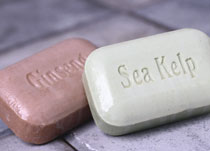VOA慢速英语 2008 1208a(在线收听)
One of the best ways to protect yourself and other people from getting sick is to wash your hands with soap. To make soap, you need three main things: oil, water and lye.
The oil can come from animal fat or plant sources like avocado, coconut or sunflower. Lye can be found at markets and other stores that sell cleaning products. Lye -- spelled l-y-e -- is also called sodium hydroxide or potassium hydroxide.
Be very careful. Lye can cause serious burns. It can also blind a person if it gets into the eyes. Do not breathe lye and do not let small children near it. And do not store lye in containers made of aluminum. The lye will eat through the metal.
 |
| Soap can be made from many different kinds of fats and additives |
But the owner of a soap making business in California says on her blog that there is no lye present in the finished soap. Diane Longacre says the lye and oil molecules combine and chemically change into soap and glycerin. Her blog is at frontierangelsoap.blogspot.com.
Some people make soap with potash lye. You boil ashes in water until only dry black salts remain. Once the salts melt, a gray-white substance is left. This is potash.
One simple way to make soft soap requires nine kilograms of potash. You also need twelve kilos of any kind of oil and twenty-six liters of water. Mix the potash well with the water. Add it to the oil in a wooden bucket.
For the next three days, mix the materials well with a wooden stick or spoon. Do this several times a day for about three minutes at a time. Then let the soap sit in the wooden bucket for about a month. After that, it will be ready to use.
In Mali, women's groups make and sell soap produced with jatropha seeds. In Rwanda, a group of people living with H.I.V./AIDS began making soap from local materials like palm oil and avocados. They developed a business with a loan from the aid organization Africare.
Healthier members of the group meet four times a week to mix the soap and cut it into pieces. An American organization called InterAction says the soap makers produce one thousand pieces each day. The soap is sold to the local health center, to a prison and to people in the community.
And that's the VOA Special English Development Report, written by Karen Leggett. More information about the soap making process can be found at practicalaction.org. Click on Practical Answers and enter "soap" as a search term. We will post helpful links at voaspecialenglish.com. I'm Mario Ritter.